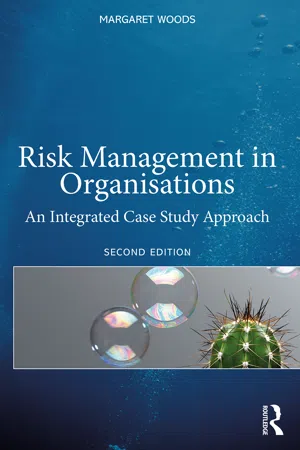
- 228 pages
- English
- ePUB (mobile friendly)
- Available on iOS & Android
About this book
Risk management is vital to organisational success, from government down to small businesses, and the discipline has developed rapidly over the last decade. Learning lessons from the good and bad practice of others is a key feature of this book, which includes multiple illustrative examples of risk management practice, in addition to detailed case studies.
Combining both theory and practice, the early chapters compare the ISO 31000 and COSO Enterprise Risk Management frameworks and the relevant regulatory regimes in both Europe and the United States. The core of the book is three highly detailed case studies of risk management in the manufacturing (Akzo Nobel), retail (Tesco), and public sectors (Birmingham City Council). Using the lessons learned from the case studies, together with material from elsewhere, the author then outlines four lessons for risk managers that can be used in any organisation seeking to develop a truly enterprise-wide risk management system.
This completely revised edition contains updates on regulations and practice, together with new chapters covering technology risk and COVID-19, which are major risks faced by all organisations today. As such the book is essential reading for risk management professionals and postgraduate and executive learners.
Frequently asked questions
- Essential is ideal for learners and professionals who enjoy exploring a wide range of subjects. Access the Essential Library with 800,000+ trusted titles and best-sellers across business, personal growth, and the humanities. Includes unlimited reading time and Standard Read Aloud voice.
- Complete: Perfect for advanced learners and researchers needing full, unrestricted access. Unlock 1.4M+ books across hundreds of subjects, including academic and specialized titles. The Complete Plan also includes advanced features like Premium Read Aloud and Research Assistant.
Please note we cannot support devices running on iOS 13 and Android 7 or earlier. Learn more about using the app.
Information
1 Introduction to This Book
Why This Book Is Important
Contents and Use
Reference
- World Economic Forum (2021) The Global Risks Report 2021: 16th Edition. World Economic Forum, Geneva, Switzerland.
2 Risk and Governance
Aim
- The link between risk management and corporate governance
- The history of governance regulations and alternative forms of regulation
- The need to recognise that regulatory compliance can create an illusion that risks are under control
What Is Corporate Governance?
History of Corporate Governance Regulations
Phase One: 1990–2010
UK History
- An implicit requirement on directors to ensure that a proper system of internal control is in place
- Publication in the report and accounts of a statement by directors on whether they comply with the code and identifying and giving reasons for any non-compliance
- The encouragement of directors to make a statement in the annual report on the effectiveness of their system of internal control, with such statements subject to review by the auditors before publication
- Separation of the role of the chief executive officer (CEO) and chairman
- The appointment of sufficient non-executive directors to ensure they can exercise influence in decision making
- The establishment of an audit committee made up of non-executive directors
- A committee made up of a majority of non-executive directors should b...
Table of contents
- Cover
- Half Title
- Title
- Copyright
- Contents
- List of Illustrations
- List of Tables
- Foreword
- Preface
- Acknowledgements
- 1 Introduction to This Book
- 2 Risk and Governance
- 3 International Standards for Risk and Enterprise Management
- 4 Risk Management in Theory and Practice
- 5 Managing Technology Risk
- 6 Enterprise Risk Management in Manufacturing: The Case of Akzo Nobel (2000–2020)
- 7 Risk Management in Retail: Tesco PLC (2004–2019)
- 8 Risk Management in the Public Sector: Birmingham City Council (2002–2020)
- 9 Best Practice Risk Management: Key Lessons
- 10 A Risk Management Perspective on COVID-19
- Index